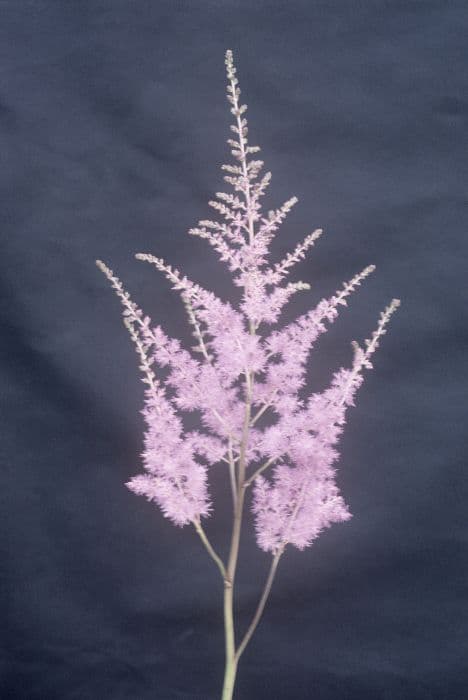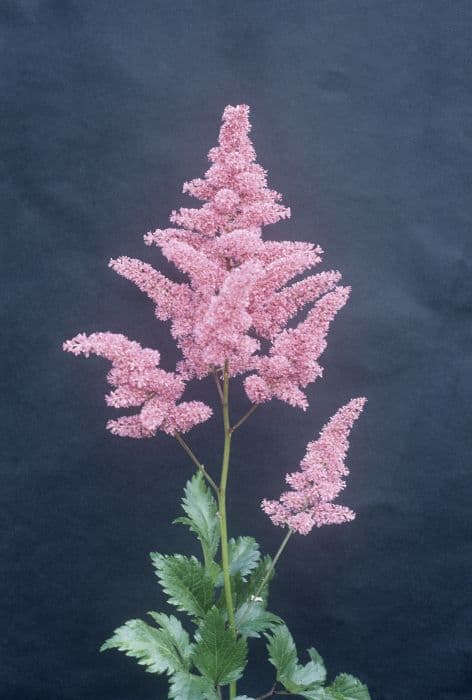False Spirea Astilbe 'Queen of Holland' (japonica hybrid)

ABOUT
Astilbe 'Queen of Holland' is a perennial plant noted for its attractive and feathery flower plumes. This variety is part of the Astilbe group known for its lush foliage and vibrant flowers. The leaves are deeply cut, resembling ferns, and typically boast a rich green hue, providing a nice contrast to the flowers. The signature trait of the 'Queen of Holland' is its plumes of flowers, which emerge in dense, pyramidal-shaped clusters. These blossoms have a fluffy appearance and are usually a soft pink to intense pink color, creating a striking visual when they bloom in the late spring to early summer. The individual flowers are quite small, but they are so numerous that they form a thick, cloud-like mass on each flower stalk. These attractive plumes can add a bright pop of color to any garden space. Moreover, the flowers are commonly used in cut flower arrangements due to their distinct look and longevity. Not only are the flowers showy, but the plant also has a bushy appearance with its mass of foliage, which remains visually pleasing even when the plant is not in bloom. Dense and frothy, the blooms stand above the foliage on sturdy stems, creating a layered look in the garden. This makes Astilbe 'Queen of Holland' a favored choice among gardeners for adding texture and color to shady garden beds or borders.
About this plant
 Names
NamesFamily
Saxifragaceae
Synonyms
False Spirea, False Goat's Beard, Feather Flower
Common names
Astilbe japonica 'Queen of Holland'.
 Toxicity
ToxicityTo humans
Astilbe, commonly referred to by its common name, is generally considered non-toxic to humans. There are no well-documented cases or concerns of poisoning from ingestion or contact. Hence, incidental contact or accidental ingestion of this plant by humans is unlikely to result in any symptoms or serious consequences.
To pets
Astilbe is also regarded as non-toxic to pets. It does not contain any known toxic compounds that would pose a risk to animals if ingested. Therefore, if pets were to ingest parts of this plant, they are not expected to suffer from poisoning or exhibit symptoms that would be harmful to their health.
 Characteristics
CharacteristicsLife cycle
Perennials
Foliage type
Deciduous
Color of leaves
Green
Flower color
Pink
Height
2 feet (60 cm)
Spread
2 feet (60 cm)
Plant type
Herb
Hardiness zones
4
Native area
Asia
Benefits
 General Benefits
General Benefits- Attractive Flowers: The Astilbe 'Queen of Holland' is known for its showy plumes of flowers that add a splash of color to any garden.
- Shade Tolerance: This plant thrives in shady areas where other flowering plants might not grow as well, making it ideal for woodland gardens or shaded borders.
- Low Maintenance: Astilbe requires minimal care once established, making it a great choice for busy gardeners or those looking for low-maintenance landscaping options.
- Long Blooming Period: It has a relatively long flowering period during the summer months, providing long-lasting visual interest.
- Drought Resistance: Once established, it can tolerate periods of dryness, although it prefers moist conditions.
- Attracts Wildlife: Its flowers are attractive to pollinators, such as butterflies, which can help to increase the biodiversity of a garden.
- Seasonal Interest: Astilbe has attractive foliage that adds interest to the garden even when the plant is not in bloom.
- Variety of Uses: It's suitable for use in mixed borders, as a focal point, or in mass plantings for a dramatic effect.
- Erosion Control: Astilbe's root system can help to stabilize soil and prevent erosion on slopes or in areas with loose soil.
- Winter Interest: The dried flower plumes can provide visual interest in the garden even during the winter months.
 Medical Properties
Medical PropertiesThis plant is not used for medical purposes.
 Air-purifying Qualities
Air-purifying QualitiesThis plant is not specifically known for air purifying qualities.
 Other Uses
Other Uses- Astilbe can be used in art projects, such as pressing the leaves and flowers to create natural designs in handmade paper or bookmarks.
- The flowers of Astilbe are sometimes dried and incorporated into potpourri mixtures, adding texture and color along with fragrance oils.
- These plants can be used for natural dyeing processes, where the flowers may produce subtle hues on fabric or yarn.
- Astilbe's dense foliage provides hiding spots and microhabitats for small beneficial insects, offering a form of biological pest control in the garden.
- The flower spikes can be used in crafts, such as creating miniature trees or accents in fairy gardens and model landscapes.
- When planted en masse, Astilbe can be used as a living mulch to help retain soil moisture and suppress weeds in garden beds.
- With their attractive foliage, Astilbe can be used to enhance the aesthetics of rain gardens, drawing attention to water conservation efforts.
- Their feathery blooms can be used to add a delicate touch to wreaths or other floral arrangements, complementing more substantial blooms.
- As a transitional plant in garden design, Astilbe can provide a visual bridge between more structured and wild, natural areas of a landscape.
- In photography, the striking appearance of Astilbe flowers makes them a good subject for botanical photo series, illustrating plant growth stages.
Interesting Facts
 Feng Shui
Feng ShuiThe Astilbe is not used in Feng Shui practice.
 Zodiac Sign Compitability
Zodiac Sign CompitabilityThe Astilbe is not used in astrology practice.
 Plant Symbolism
Plant Symbolism- Patience and Dedication: Astilbes take a while to grow and bloom, symbolizing the virtues of patience and the rewards of dedication and hard work.
- Hope and Endurance: These plants can thrive in shady gardens where other plants may falter, which makes them a symbol for hope and enduring through difficult conditions.
- I'll Still Be Waiting: The long-lasting blooms of the Astilbe can also be a reminder of steadfastness in love or friendship, implying a readiness to wait for someone.
- Protection and Safety: The dense foliage and flowers of Astilbe provide cover in gardens, often symbolizing protection and a safe haven.
 Water
WaterFalse Spirea should be consistently watered to keep the soil moist without becoming soggy. Generally, it requires watering once or twice a week, depending on weather conditions and soil moisture levels. During the growing season, aim to provide about 1 inch of water per week, either through rainfall or manual watering. If you need to supplement with manual watering, that would approximately translate to 0.62 gallons for a small-medium sized plant. Ensure you're watering directly at the base of the plant to avoid wetting the foliage, which can lead to fungal diseases.
 Light
LightFalse Spirea thrives in dappled sunlight to partial shade. It does best when protected from the harsh afternoon sun, so an ideal spot would be one that gets morning sun and afternoon shade. This will help maintain vibrant foliage and encourage plentiful blooms. A location under the light shade of taller trees or on the north side of a building where it can receive bright, indirect light is often ideal.
 Temperature
TemperatureFalse Spirea prefers moderate temperatures and will tolerate a range from approximately 40 to 75 degrees Fahrenheit. Extreme heat can stress the plant, particularly if it isn't kept sufficiently moist. It is generally hardy in USDA zones 4 through 8, which indicates it can survive winter temperatures as low as -30 to -20 degrees Fahrenheit. Ideal temperatures for promoting lush growth and vibrant blooms are between 60 and 70 degrees Fahrenheit.
 Pruning
PruningPruning False Spirea is mainly done to remove spent flowers and encourage additional blooming. After the initial flowering in late spring or early summer, prune back the flowering stalks to encourage a second, albeit less profuse, bloom period. Pruning should be light, focusing only on dead or damaged stems and spent blooms. The best time for a more extensive pruning is late winter or early spring before new growth starts.
 Cleaning
CleaningAs needed
 Soil
SoilAstilbe, commonly referred to as False Spirea, thrives in rich, moist, organic soil with a pH range of 6.0 to 8.0. The ideal soil mix for False Spirea is a blend of garden soil, compost, and peat moss to retain moisture yet provide good drainage.
 Repotting
RepottingFalse Spirea typically doesn't require frequent repotting and can be repotted every 3-4 years or when the roots become crowded in the container.
 Humidity & Misting
Humidity & MistingFalse Spirea prefers a high humidity environment, thriving best in conditions that replicate its native woodland habitat.
 Suitable locations
Suitable locationsIndoor
Keep in moist soil, indirect light.
Outdoor
Plant in part shade, ensure moist, rich soil.
Hardiness zone
4-8 USDA
 Life cycle
Life cycleAstilbe 'Queen of Holland' begins its life as a perennial rootstock or rhizome that, once planted, will sprout foliage in early spring. As temperatures warm, it produces feathery plumes of flowers, ranging from pink to red, that bloom in late spring to early summer. After flowering, the plant sets seed, which can be dispersed for propagation, though it primarily expands through its rhizome system. As autumn approaches, the plant's foliage turns yellow and dies back, entering a period of dormancy through the winter months. In subsequent years, it will re-emerge from dormancy in the spring, repeating the cycle and gradually increasing in clump size. Through division every few years, gardeners can manage its growth and propagate new plants to expand their garden display.
 Propogation
PropogationPropogation time
Late Winter to Early Spring
Astilbe 'Queen of Holland' can be propagated most successfully through division of the clumps. The best time to divide the astilbe plants is in the spring or early fall when the temperatures are cool, which helps reduce stress on the plants. When dividing, a gardener should carefully dig up the entire clump of the plant, ensuring that each section has at least two or three growth buds. Then, using a sharp knife or spade, they can split the clump into smaller pieces, which should be immediately replanted at the same soil depth as before. It's important to maintain adequate moisture after planting to encourage root development. Dividing every 3 to 4 years not only creates new plants but also rejuvenates the older clumps, as crowded plants often decline in vigor and bloom quality.









